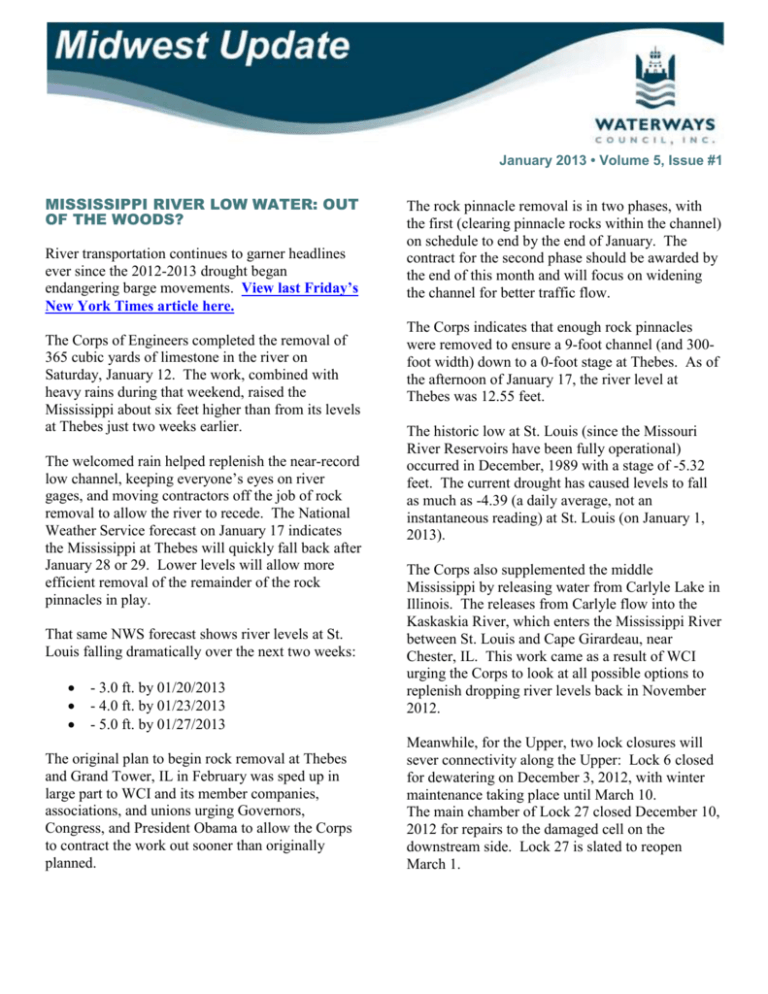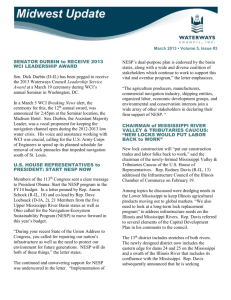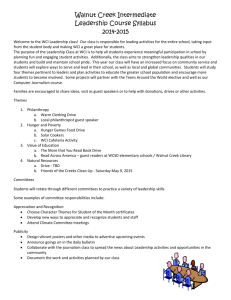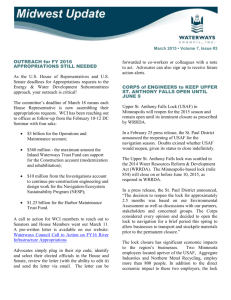January 2013 • Volume 5, Issue #1 MISSISSIPPI RIVER LOW
advertisement

January 2013 • Volume 5, Issue #1 MISSISSIPPI RIVER LOW WATER: OUT OF THE WOODS? River transportation continues to garner headlines ever since the 2012-2013 drought began endangering barge movements. View last Friday’s New York Times article here. The Corps of Engineers completed the removal of 365 cubic yards of limestone in the river on Saturday, January 12. The work, combined with heavy rains during that weekend, raised the Mississippi about six feet higher than from its levels at Thebes just two weeks earlier. The welcomed rain helped replenish the near-record low channel, keeping everyone’s eyes on river gages, and moving contractors off the job of rock removal to allow the river to recede. The National Weather Service forecast on January 17 indicates the Mississippi at Thebes will quickly fall back after January 28 or 29. Lower levels will allow more efficient removal of the remainder of the rock pinnacles in play. That same NWS forecast shows river levels at St. Louis falling dramatically over the next two weeks: - 3.0 ft. by 01/20/2013 - 4.0 ft. by 01/23/2013 - 5.0 ft. by 01/27/2013 The original plan to begin rock removal at Thebes and Grand Tower, IL in February was sped up in large part to WCI and its member companies, associations, and unions urging Governors, Congress, and President Obama to allow the Corps to contract the work out sooner than originally planned. The rock pinnacle removal is in two phases, with the first (clearing pinnacle rocks within the channel) on schedule to end by the end of January. The contract for the second phase should be awarded by the end of this month and will focus on widening the channel for better traffic flow. The Corps indicates that enough rock pinnacles were removed to ensure a 9-foot channel (and 300foot width) down to a 0-foot stage at Thebes. As of the afternoon of January 17, the river level at Thebes was 12.55 feet. The historic low at St. Louis (since the Missouri River Reservoirs have been fully operational) occurred in December, 1989 with a stage of -5.32 feet. The current drought has caused levels to fall as much as -4.39 (a daily average, not an instantaneous reading) at St. Louis (on January 1, 2013). The Corps also supplemented the middle Mississippi by releasing water from Carlyle Lake in Illinois. The releases from Carlyle flow into the Kaskaskia River, which enters the Mississippi River between St. Louis and Cape Girardeau, near Chester, IL. This work came as a result of WCI urging the Corps to look at all possible options to replenish dropping river levels back in November 2012. Meanwhile, for the Upper, two lock closures will sever connectivity along the Upper: Lock 6 closed for dewatering on December 3, 2012, with winter maintenance taking place until March 10. The main chamber of Lock 27 closed December 10, 2012 for repairs to the damaged cell on the downstream side. Lock 27 is slated to reopen March 1. January 2013 • Volume 5, Issue #1 WCI PUBLIC EDUCATION 2013 KICKS OFF IN NASHVILLE Waterways Council joined the estimated 6,000 farmer and rancher members of American Farm Bureau Federation (AFBF) at their 94th annual meeting in Nashville this week. The event, themed “Many Voices, One Vision” included a display by WCI on their trade show floor. The WCI presence was of major interest to AFBF members, primarily a result of the massive media attention that low water challenges to river traffic has received over the past few months. AFBF President Bob Stallman highlighted the ability to move up the U.S. Army Corps of Engineers’ deadlines for rock removal as a “win” for agriculture. And the work isn’t finished. “The drought continues to affect agriculture,” stated Stallman. “Transportation on the Mississippi River and other inland waterways is threatened by severely low water levels.” Stallman urged continued activity from AFBF members, noting the power of grassroots activism. “Rural voter turnout surpasses the national average. Farm Bureau members embrace their right and responsibility to vote,” Stallman stated. “And as anyone who is familiar with Farm Bureau knows, our members are active in engaging with their elected officials throughout the year to advocate for the policies that our grassroots leaders have said are vital to the success of agriculture and our nation.” The Monday afternoon “Transportation & Agriculture” panel included former WCI chairman (and current executive committee member) Dan Mecklenborg of Ingram Barge Company. The forum addressed the impacts the ban on Congressionally-directed spending, or earmarks, has had on the infrastructure relied on by the agriculture community. Uncertain funding and disjointed planning also impacts transportation infrastructure progress, and with it, the reliability for American farmers to get their product to markets worldwide. Barge transportation in particular received much attention, in part due to the media focus on the impacts of the current drought. Low river levels are directly affecting American farming families, from the timely transportation of grain for export, to moving fertilizer and other inputs needed for the 2013 crop in a timely and cost-effective manner. The viability of American ports and the impacts of the Panama Canal were also discussed. The principle takeaway for the panel audience was summed with a call for farmers to highlight the important role transportation plays in their operations and to engage with their elected officials. “We need grassroots involvement and (Farm Bureau) members chewing on the ears of Members in Congress,” Samuel Kieffer, national governmental relations director for Pennsylvania Farm Bureau, reiterated. Read the January 15 AFBF media release: "Efficient Transportation Remains Critical for Farmers" here. January 2013 • Volume 5, Issue #1 IOWA GOVERNOR BRANSTAD HOSTS RIVER NAVIGATION INFRASTRUCTURE MEETING: WCI FEATURED PARTICIPANT Iowa Governor Terry Branstad is hosting a river transportation meeting February 5, and WCI has been asked to help lead a panel examining how the Mississippi connects Iowa to the global economy. The forum will allow state leaders to hear from stakeholders on the importance of the river to their livelihood, business, and industry competitiveness and to gain perspective on how stakeholders think the system should be managed moving forward. Gov. Branstad and Lt. Gov. Kim Reynolds will be joined by state agencies as well as the U.S. Army Corps of Engineers and other relevant federal agency representatives. The purpose of the meeting is to discuss concerns regarding shortfalls in lock and dam infrastructure and how it will impact Iowa’s economic development. In a statement to WCI, Gov. Branstad said, “The Mississippi River is a vital link to connect Iowa exports to the world market. The river helps give Iowa a competitive advantage in a variety of industries, including agriculture.” The governor continued, “Lt. Governor Reynolds and I look forward to meeting with key stakeholders to begin conversations on how we can think about the challenges anew and how we can build an effective coalition to make progress and identify a long-term economically sustainable way to manage the River system.” Gov. Branstad’s January 15 Condition of the State address highlighted Iowa’s economic opportunities, including its status as an exporter of grains to some of China’s 1.3 billion residents. Gov. Branstad highlighted the budding relationship with China’s leadership, stemming from a visit by China’s Vice President (and next president) Xi Jinping last year. That trip included the signing of an agreement to provide $4.3 billion in soybeans to China. The February 5 discussion will be open to the public, but interested individuals should RSVP to Jake.Ketzner@Iowa.Gov to ensure a seat. The meeting will run 10:30 a.m. - 12:30 p.m. (CST) at the Hotel Blackhawk’s “Gold Room,” 200 E. 3rd Street, Davenport, Iowa 52801 ASIAN CARP NOW MUSEUM FEATURE Visitors to Chicago’s Shedd Aquarium can now view three Asian bighead carp. The fish debuted at the museum December 20, 2012. The very presence of these three fish underscore the fact that carp can be introduced into a body of water through unintentional, or even intentional, human efforts – actions not associated with locks or river transportation operations. Fisheries biologists with the Illinois Department of Natural Resources found the carp in an inland lagoon at Chicago's Humboldt Park back in October 2012. Biologists at the Shedd Aquarium were hoping the addition of three Asian bighead carp to the Invasive Species exhibit would persuade visitors to help keep the voracious fish out of Lake Michigan. Aquarium vice president Roger Germann pointed out the three carp didn’t get into the Humboldt Park lagoon by themselves. “The reality is, (the lagoon) is not connected to any waterways,” he said. “While we may never know how they got in there, I think all of us kind of agree that there’s a couple ways that we find invasive species like Asian carp January 2013 • Volume 5, Issue #1 making their way in these lagoons, through unintentional discharge of bait, or it could have been through an unintentional stocking at that time.” This is yet another example of how possible misguided or even nefarious human actions can impact the public discourse on this important issue. ST. LOUIS RIVER INDUSTRY CLUB MEETS JANUARY 23 The first 2013 luncheon of the St. Louis River Industry Club begins at 11:30 a.m. on Wednesday, January 23 at the Hilton St. Louis Frontenac. Attendance is free, thanks to each month’s sponsor. January’s sponsor is American Milling. Lunch is served at noon followed by a discussion on current coal markets. RSVP by Monday, January 21 required: STLRiverIndustry@aepriverops.com Sponsorship opportunities for the February 27 luncheon are still available. DO YOU “LIKE” US YET? Do you “Like” us? Have your joined our “Discussion”? Facebook and LinkedIn are two opportunities to plug into WCI and join our grassroots network.










